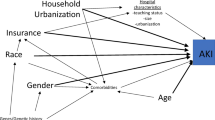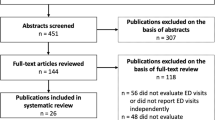Abstract
Families of children with special health care needs may travel substantial distances to access specialized health care. However, it is not known how race/ethnicity, insurance status, and access to disease-specific specialty care affect travel distances. This analysis examines patients aged 18 years or younger who were discharged from a Pediatric Health Information System (PHIS) children’s hospital (n = 52) with a diagnosis of an inherited leukodystrophy between October 1, 2015, and September 30, 2018 (n = 950 patients). Leukodystrophies are rare but very serious neurological illnesses, with elevated mortality and morbidity rates. Bivariate and hierarchical generalized linear models reveal that white children, privately insured children, and children visiting leukodystrophy specialist centers travel farther for children’s hospital care. These findings indicate that socially privileged families travel greater distances to obtain specialized health care, which could affect clinical outcomes.

Similar content being viewed by others
References
McPherson M, et al. A new definition of children with special health care needs. Pediatrics. 1998;102(1):137–40.
Yantzia N, et al. The impacts of distance to hospital on families with a child with a chronic condition. Soc Sci Med. 2001;52(12):1777–91.
Turner M, Griffin MJ. Motion sickness in public road transport: the relative importance of motion, vision and individual differences. Br J Psychol. 1999;90(4):519–30.
Mangili A, Gendreau MA. Transmission of infectious diseases during commercial air travel. Lancet. 2005;365(9463):989–96.
Silverman D, Gendreau M. Medical issues associated with commercial flights. Lancet. 2009;373(9680):2067–77.
Brady JM, et al. Why do children with severe bronchopulmonary dysplasia not attend neonatal follow-up care? Parental views of barriers. Acta Paediatrica. 2018. https://doi.org/10.1111/apa.14265.
McQuoid J, Jowsey T, Talaulikar G. Contextualising renal patient routines: everyday space-time contexts,health service access, and wellbeing. Soc Sci Med. 2017;183:142–50.
Basu J, Mobley LR. Illness severity and propensity to travel along the urban–rural continuum. Health Place. 2007;13(2):381–99.
Basu J, Cooper J. Out-of-area travel from rural and urban counties: a study of ambulatory care sensitive hospitalizations for New York State residents. J Rural Health. 2000;16(2):129–38.
Basu J, Friedman B. Preventable illness and out-of-area travel of children in New York counties. Health Econ. 2001;10:67–78.
Cook PA, et al. Influence of socio-demographic factors on distances travelled to access HIV services: enhanced surveillance of HIV patients in north west England. BMC Public Health. 2009;9(78). https://doi.org/10.1186/1471-2458-9-78.
Lorch SA, Silber JH, Even-Shoshan O, Millman A. Use of prolonged travel to improve pediatric risk-adjustment models. Health Serv Res. 2009;44(2 pt 1):519–41.
Radcliff E, Delmelle E, Kirby RS, Laditka SB, Correia J, Cassell CH. Factors associated with travel time and distance to access hospital care among infants with spina bifida. Matern Child Health J. 2016;20(1):205–17.
Malik A, et al. Recurrence of inguinal hernias repaired in a large hernia surgical specialty hospital and general hospitals in Ontario, Canada. Can J Surg. 2016;59(1):19–25.
Dunlop S, Coyte PC, McIsaac W. Socio-economic status and the utilisation of physicians’ services: results from the Canadian National Population Health Survey. Soc Sci Med. 2000;51(1):123–33.
Sultan DH, Gishe J, Hanciles A, Comins MM, Norris CM. Minority use of a National Cancer Institute-Designated Comprehensive Cancer Center and non-specialty hospitals in two Florida regions. J Racial Ethn Health Disparities. 2015;2(3):373–84.
Skinner AC, Mayer ML. Effects of insurance status on children’s access to specialty care: a systematic review of the literature. BMC Health Serv Res. 2007;7:194.
Bisgaier J, Rhodes KV. Auditing access to specialty care for children with public insurance. N Engl J Med. 2011;364:2324–33.
Mukherjee D, Zaidi HA, Kosztowski T. Disparities in access to neuro-oncologic care in the United States. JAMA Surg. 2010;145(3):247–53.
Rysavy MA, Li L, Bell EF, Das A, Hintz SR, Stoll BJ, et al. Between-hospital variation in treatment and outcomes in extremely preterm infants. N Engl J Med. 2015;372:1801–11.
Lucas FL, Stukel TA, Morris AM, Siewers AE, Birkmeyer JD. Race and surgical mortality in the United States. Ann Surg. 2006;243(2):281–6.
Bourdieu P. The forms of capital. In: Richardson JG, editor. Handbook of theory and research for the sociology of education. New York: Greenwood Press; 1986. p. 241–57.
Abel T, et al. Money is not enough: exploring the impact of social and cultural resources on youth health. Scand J Public Health. 2011;39(Suppl 6):57–61.
Abel T. Cultural capital in health promotion. In: McQueen DV, Kickbush I, editors. Health and modernity: the role of theory in health promotion. New York: Springer; 2007. p. 43–73.
Madden EF. Cultural health capital on the margins: cultural resources for navigating healthcare in communities with limited access. Soc Sci Med. 2015;133:145–53.
Bourdieu P. Sociology in question. London: Sage; 1993.
Grineski SE. Parental accounts of Children’s asthma care: the role of cultural and social capital in health disparities. Sociol Focus. 2009;42(2):107–32.
Shim JK. Cultural health capital: a theoretical approach to understanding health care interactions and the dynamics of unequal treatment. J Health Soc Behav. 2010;51(1):1–15.
Bonkowsky JL, Nelson C, Kingston JL, Filloux FM, Mundorff MB, Srivastava R. The burden of inherited leukodystrophies in children. Neurology. 2010;75(8):718–25.
Bonkowsky JL, Wilkes J, Bardsley T, Urbik VM, Stoddard G. Association of diagnosis of leukodystrophy with race and ethnicity among pediatric and adolescent patients. JAMA Netw Open. 2018;1(7):e185031.
Brimley CJ, Lopez J, van Haren K, Wilkes J, Sheng X, Nelson C, et al. National variation in costs and mortality for leukodystrophy patients in US children’s hospitals. Pediatr Neurol. 2013;49(3):156–62.
Richards J, et al. Targeted leukodystrophy diagnosis based on charges and yields for testing. Am J Med Genet A. 2015;167(11):2541–3.
Adang LA, Sherbini O, Ball L, Bloom M, Darbari A, Amartino H, et al. Revised consensus statement on the preventive and symptomatic care of patients with leukodystrophies. Mol Genet Metab. 2017;122(1–2):18–32.
Berry JG, et al. Trends in resource utilization by children with neurological impairment in the United States inpatient health care system: a repeat cross-sectional study. PLoS Med. 2012;9(1):e1001158.
Kittle K, Currier K, Dyk L, Newman K. Using a pediatric database to drive quality improvement. Semin Pediatr Surg. 2002;11(1):60–3.
Bliss RL, Katz JN, Wright EA, Losina E. Estimating proximity to care: are straight line and zipcode centroid distances acceptable proxy measures? Med Care. 2012;50(1):99–106.
Saunders MR, Lee H, Maene C, Schuble T, Cagney KA. Proximity does not equal access: racial disparities in access to high quality dialysis facilities. J Racial Ethn Health Disparities. 2014;1(4):291–9.
Lee C. “Race” and “ethnicity” in biomedical research: how do scientists construct and explain differences in health?☆. Soc Sci Med. 2009;68(6):1183–90.
Hicken MT, Kravitz-Wirtz N, Durkee M, Jackson JS. Racial inequalities in health: framing future research. Soc Sci Med. 2018;199:11–8.
Peltz A, et al. Characteristics of rural children admitted to pediatric hospitals. Pediatrics. 2016;137(5):e20153156.
Health Resources and Services Administration. Shortage designation. 2019 [19 June 2019]; Available from: https://bhw.hrsa.gov/shortage-designation.
RUCA. Map classifications. n.d.. Available from: http://depts.washington.edu/uwruca/ruca-maps.php. Accessed 13 July 2019.
Raudenbush SW, Bryk AS. Hierarchical linear models: applications and data analysis methods. Thousand Oaks: Sage; 2002.
Spybrook J, et al. Optimal design plus empirical evidence: documentation for the “Optimal Design” software: Western Michigan University; 2011, 215.
Cohen J. Statistical power for the behavioral sciences. Hillsdale: Erlbaum; 1988.
Grineski SE, et al. Geographic and specialty access disparities in U.S. pediatric leukodystrophy diagnosis. J Pediatr. 2020;In Press.
Mayer M. Are we there yet? Distance to care and relative supply among pediatric medical subspecialties. Pediatrics. 2006;118(6). https://doi.org/10.1542/peds.2006-1570.
Bach PB, Pham HH, Schrag D, Tate RC, Hargraves JL. Primary care physicians who treat blacks and whites. N Engl J Med. 2004;351:575–84.
Dimick J, et al. Black patients more likely than whites to undergo surgery at low-quality hospitals in segregated regions. Health Aff. 2013;32(6).
Lee KJ, Scott D. Racial discrimination and African Americans’ travel behavior: the utility of habitus and vignette technique. J Travel Res. 2017;56(3):381–92.
Ge Y, et al. In: N.B.o.E. Research, editor. Racial and gender discrimination in transportation network companies. Cambridge: National Bureau of Economics Research; 2016.
Yu S. “I am like a deaf, dumb and blind person”: mobility and immobility of Chinese (im) migrants in Flushing, Queens, New York City. J Transp Geogr. 2016;54:10–21.
Schiltz NK, Koroukian SM, Singer ME, Love TE, Kaiboriboon K. Disparities in access to specialized epilepsy care. Epilepsy Res. 2013;107(1–2):172–80.
HCUP Kids’ Inpatient Database (KID). Healthcare cost and utilization project (HCUP). A.f.H.R.a. Quality, Editor. Rockville, M.; 2016.
Peipins LA, Graham S, Young R, Lewis B, Flanagan B. Racial disparities in travel time to radiotherapy facilities in the Atlanta metropolitan area. Soc Sci Med. 2013;89:32–8.
Bikdeli B, Wayda B, Bao H, Ross JS, Xu X, Chaudhry SI, et al. Place of residence and outcomes of patients with heart failure: analysis from the telemonitoring to improve heart failure outcomes trial. Circ: Cardiovasc Qual Outcomes. 2014;7(5):749–56.
Sessa M, Lorioli L, Fumagalli F, Acquati S, Redaelli D, Baldoli C, et al. Lentiviral haemopoietic stem-cell gene therapy in early-onset metachromatic leukodystrophy: an ad-hoc analysis of a non-randomised, open-label, phase 1/2 trial. Lancet. 2016;388(10043):476–87.
Eichler F, et al. Hematopoietic stem-cell gene therapy for cerebral adrenoleukodystrophy. N Engl J Med. 2017;26(377):1630–8.
Wells KJ, Battaglia TA, Dudley DJ, Garcia R, Greene A, Calhoun E, et al. Patient navigation: state of the art or is it science? Cancer. 2008;113(8):1999–2010.
Acknowledgements
The study was supported by NIH grant 3UL1TR002538-01S1. JLB is also supported by NIH grant U54NS115052-01, and by the Bray Presidential Chair in Child Neurology research. DXM is supported by NIH grants RL5GM118969, TL4GM118971, and UL1GM118970.
Author information
Authors and Affiliations
Corresponding author
Ethics declarations
Conflict of Interest
The last author has served as a consultant to Bluebird Bio, Inc.; Calico Life Sciences; Neurogene, Inc.; and to Enzyvant; is on the Board of Directors of wfluidx, Inc.; and owns stock in Orchard Therapeutics.
Ethical Approval
This article does not contain any studies with human participants or animals performed by any of the authors.
Additional information
Publisher’s Note
Springer Nature remains neutral with regard to jurisdictional claims in published maps and institutional affiliations.
Rights and permissions
About this article
Cite this article
Grineski, S.E., Morales, D.X., Collins, T. et al. Racial/Ethnic and Insurance Status Disparities in Distance Traveled to Access Children’s Hospital Care for Severe Illness: the Case of Children with Leukodystrophies. J. Racial and Ethnic Health Disparities 7, 975–986 (2020). https://doi.org/10.1007/s40615-020-00722-w
Received:
Revised:
Accepted:
Published:
Issue Date:
DOI: https://doi.org/10.1007/s40615-020-00722-w




